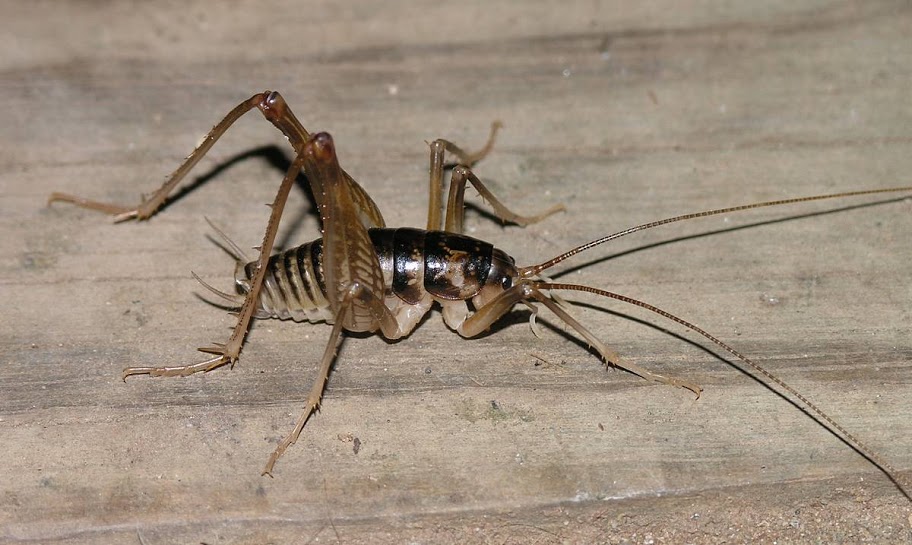1. Introduction: What Is a Cave Cricket?

If you’ve ever entered a damp basement, an old barn, or an actual cave and seen a strange, long-legged insect jumping around, you’ve probably met a cave cricket. Also known as camel crickets or spider crickets, these fascinating creatures belong to the family Rhaphidophoridae. Their name comes from their favorite habitat — dark, moist environments where they can hide from predators and thrive away from sunlight.
Unlike the cheerful chirping of field crickets, cave crickets are silent. They don’t have wings or sound-producing organs, which is why their presence can take people by surprise. What makes them interesting (and a little creepy to some) is their spider-like appearance and their unpredictable jumping. Their long, curved legs allow them to leap several feet in the air, often directly toward a person — though not out of aggression, but confusion.
Cave crickets are found all over the world, especially in humid regions. They’re not harmful, but they can become a nuisance when they invade homes in search of moisture or food. Despite their unsettling looks, they play a valuable role in nature by helping decompose organic material like fungi, wood, and decaying leaves. Understanding these insects helps us appreciate their place in the ecosystem — and better manage them when they get too close for comfort.
2. The Scientific Classification of Cave Crickets
To truly understand what a cave cricket is, let’s break down its scientific classification:
| Category | Classification |
|---|---|
| Kingdom | Animalia |
| Phylum | Arthropoda |
| Class | Insecta |
| Order | Orthoptera |
| Family | Rhaphidophoridae |
| Common Names | Cave cricket, camel cricket, spider cricket |
Cave crickets belong to the Orthoptera order — the same group as grasshoppers and field crickets — but differ in several significant ways. For example, they lack wings and produce no chirping sounds, unlike their field cricket cousins. Their family name, Rhaphidophoridae, is derived from Greek, meaning “needle-bearing,” which refers to the long ovipositor (egg-laying structure) that females possess.
These insects have evolved over millions of years to adapt to dark environments. Some species live exclusively in caves, while others inhabit forest floors, under logs, or in human-made structures. They share some similarities with other Orthopterans, such as their jumping ability, but their appearance and behavior set them apart.
Interestingly, there are more than 100 species of cave crickets worldwide, with around 20 found in North America alone. The most common type found in homes in the United States is the Diestrammena asynamora, also known as the greenhouse camel cricket. Whether they’re hiding in natural caves or lurking in basements, these crickets have mastered the art of survival in low-light, high-moisture environments.
3. Physical Characteristics of Cave Crickets
Cave crickets have a distinctive look that makes them easy to identify — and hard to forget. Their bodies are usually light brown to dark tan, often with darker bands or mottled patterns that help them blend into their surroundings. Their most striking feature is their arched back, giving them the nickname “camel cricket.” This humped appearance allows them to jump powerfully and maneuver easily in tight spaces.
They typically measure ½ inch to 1½ inches in body length, but when you include their long antennae and legs, they can appear much larger. Their antennae are extremely long, often extending several times the length of their body, helping them sense obstacles in dark environments where vision is limited.
Unlike most other crickets, cave crickets are wingless. Instead, their hind legs are built for jumping, giving them an impressive leap that can startle anyone encountering them unexpectedly. These legs also serve a defensive function — when threatened, they jump toward movement to confuse predators, a tactic that often scares humans by accident.
Their exoskeleton is tough but flexible, allowing them to squeeze through small openings or crevices. This makes them surprisingly good at finding their way into basements, crawl spaces, or under decks. Combined with their ability to survive on minimal food, their physical adaptations make cave crickets a prime example of nature’s ability to equip even small creatures for survival in challenging environments.
4. Where Do Cave Crickets Live?
Cave crickets love environments that mimic their natural homes — dark, damp, and quiet spaces. As their name suggests, they’re often found in caves, where the humidity and temperature remain relatively stable. However, in modern times, they’ve adapted to human environments that provide similar conditions.
You’ll frequently find them in:
-
Basements and crawl spaces
-
Under decks or porches
-
Sheds, garages, and barns
-
Old wells or storm drains
-
Natural areas like leaf litter, rotting logs, and under stones
These areas offer shelter from sunlight and predators while maintaining the moisture they need to survive. Cave crickets can’t live in dry conditions for long because their bodies lose water quickly through evaporation. That’s why they often invade homes during hot or dry weather — your basement might be their best available refuge.
Their ability to adapt to human spaces has made them a common household pest in many parts of the world. They don’t cause direct damage like termites, but they can chew on fabrics, paper, and even stored items when food sources are scarce. Their presence is often a sign of excessive humidity, so controlling moisture is key to keeping them away.
5. Cave Cricket Behavior and Lifestyle
Cave crickets are nocturnal by nature, meaning they’re most active at night. During the day, they hide in dark corners or under objects, emerging only when it’s quiet and safe. Their behaviors are largely shaped by their instinct to avoid light — they’re positively negatively phototactic, meaning they move away from light sources.
They rely on their antennae to navigate, using them like radar to detect surroundings. Since their eyesight is poor, touch and vibration are their main tools for survival. When startled, they jump erratically — often directly toward the source of movement. This reaction is purely defensive, not aggressive, as they’re trying to escape danger, not attack.
In the wild, cave crickets often live in small groups, though they’re not social insects like ants or bees. They gather in clusters mainly because they prefer similar environmental conditions. In homes, finding several together usually indicates a moisture problem attracting them to that area.
Their survival instincts are impressive — they can go weeks without food, relying on moisture and organic debris. However, in human environments, they might nibble on carpets, wood, or stored items if other resources are limited. This adaptability has allowed them to thrive in both natural and urban habitats for centuries
6. What Do Cave Crickets Eat?
Cave crickets have a surprisingly diverse diet, which helps them survive in many different environments. In the wild, they primarily act as scavengers, feeding on decaying organic matter. This includes plant debris, fungi, rotting wood, and even dead insects. Their diet helps recycle nutrients back into the ecosystem, making them a small but essential part of nature’s cleanup crew.
When they find their way into human spaces, their diet changes based on what’s available. In basements, garages, or crawl spaces, they might feed on:
-
Paper, cardboard, and wood
-
Fabrics such as wool, cotton, or silk
-
Stored grains, pet food, or crumbs
-
Dead insects or organic waste
Although cave crickets do not actively damage your home’s structure like termites or carpenter ants, they can still be destructive to household items. For instance, fabrics stored in humid environments — like clothes in a basement — may end up chewed or riddled with holes.
Their strong mouthparts allow them to nibble through soft materials easily. What’s fascinating is that they don’t eat continuously; instead, they feed intermittently depending on environmental conditions. Because they live in darkness and moisture, they rarely encounter abundant food, so their metabolism adjusts to survive long periods of scarcity.
In times of extreme starvation, cave crickets have been observed exhibiting cannibalistic behavior, eating weaker members of their group. This adaptation, though unsettling, shows how efficiently they can survive even in challenging conditions.
Ultimately, if you remove their food sources — such as organic debris and humidity — you remove their motivation to stick around.
7. Life Cycle of Cave Crickets
Understanding the life cycle of a cave cricket helps explain why infestations can persist if left unchecked. Like most insects, cave crickets undergo three main life stages: egg, nymph, and adult.
-
Egg Stage
Female cave crickets lay their eggs in moist soil or organic material. They use their long ovipositors to deposit eggs safely underground or in cracks. Each female can lay up to 100 eggs at a time, often during the warmer months. The eggs are small, oval, and whitish — and they typically hatch within 30 to 60 days, depending on humidity and temperature. -
Nymph Stage
When the eggs hatch, tiny nymphs emerge, resembling miniature adults but without fully developed legs or reproductive organs. Over several months, they molt multiple times, shedding their exoskeleton as they grow. Each molting stage brings them closer to adulthood. During this phase, they stay hidden, feeding on organic debris and avoiding light. -
Adult Stage
After about one year, nymphs mature into adults. Adult cave crickets can live for several months to a year, depending on conditions. They continue to reproduce during their adult stage, leading to overlapping generations if the environment supports them.
Because cave crickets lay eggs in hidden, moist places, controlling humidity and sealing entry points is crucial. Once established, an infestation can grow quietly over time since they reproduce in darkness and rarely leave their hiding spots. Unlike many other insects, they don’t require sunlight to thrive — which means your basement or crawl space could be an ideal breeding ground without you even knowing it.
8. Why Cave Crickets Invade Homes
Cave crickets don’t necessarily want to live with humans — they simply seek shelter, moisture, and food. Most infestations occur because your home mimics their natural environment.
Here are the main reasons they invade homes:
-
Moisture: Damp basements, crawl spaces, or bathrooms create the perfect environment.
-
Darkness: They prefer areas that stay shaded and quiet.
-
Temperature: Moderate indoor temperatures protect them from harsh outdoor conditions.
-
Food Sources: Cardboard boxes, fabrics, and organic waste provide sustenance.
They often find entry points through cracks in foundations, vent openings, or gaps around windows and doors. In some cases, they’re accidentally brought inside through firewood, storage boxes, or garden supplies.
Once inside, they establish themselves in quiet corners like behind water heaters, under laundry machines, or in cluttered storage rooms. During summer droughts or winter cold, invasions increase because outdoor conditions become unfavorable.
If you start seeing them regularly, it’s likely you have a moisture problem — a telltale sign that your home’s ventilation needs improvement. Addressing humidity through dehumidifiers, sealing leaks, and improving airflow is often the first and most effective line of defense.
9. Are Cave Crickets Dangerous?
One of the most common questions homeowners ask is: Are cave crickets dangerous? The short answer is no — cave crickets are harmless to humans and pets. They don’t bite, sting, or transmit diseases, and they’re not venomous. However, their appearance and behavior can be unsettling.
Their sudden jumps can scare people, especially when they seem to leap directly toward you. This reaction isn’t aggression — it’s simply a defense mechanism. Because cave crickets have poor eyesight, they jump randomly toward motion or vibration to escape perceived threats.
While they pose no health risks, they can become a nuisance pest when they gather in large numbers. In high populations, they may damage fabrics, paper, or stored materials. Their droppings can also accumulate, leaving stains or odor in heavily infested areas.
For pets, they’re not toxic — but curious cats or dogs may try to eat them. While a single cricket won’t cause harm, large numbers can upset a pet’s stomach.
In short, cave crickets are more of a psychological pest than a physical threat. Their spooky appearance, silent movement, and erratic jumping behavior make them seem more dangerous than they actually are.
How to Identify a Cave Cricket Infestation
Cave crickets are secretive creatures, so spotting one doesn’t necessarily mean you have an infestation. However, several signs can help you determine if they’ve taken up residence in your home.
Common Signs of Infestation
-
Frequent Sightings: Seeing multiple crickets, especially in dark, damp areas like basements or crawl spaces, is a strong indicator.
-
Droppings: Small, dark specks near walls or corners can signal their presence.
-
Chewed Materials: Look for damage on fabrics, paper, or cardboard boxes.
-
Egg Deposits: In severe infestations, you might find clusters of tiny white eggs in moist soil or behind objects.
-
Musty Smell: A heavy, earthy odor sometimes accompanies large infestations due to moisture and droppings.
You can perform a simple check by placing sticky traps in suspected areas. These traps not only capture crickets but also help you gauge the severity of the issue. If the traps fill quickly, you likely have a breeding population.
Inspect crawl spaces, garages, and under sinks, as these are their preferred hiding spots. Because they’re nocturnal, use a flashlight at night — that’s when you’re most likely to catch them in action.
If the problem persists despite using traps and dehumidifiers, it might be time to consult a pest control expert. Professionals can locate hidden colonies and apply treatments that eliminate both adult crickets and their eggs.


